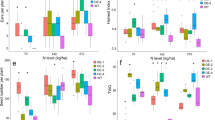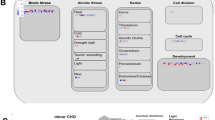Abstract
The drive toward more sustainable agriculture has raised the profile of crop plant nutrient-use efficiency. Here we show that a major rice nitrogen-use efficiency quantitative trait locus (qNGR9) is synonymous with the previously identified gene DEP1 (DENSE AND ERECT PANICLES 1). The different DEP1 alleles confer different nitrogen responses, and genetic diversity analysis suggests that DEP1 has been subjected to artificial selection during Oryza sativa spp. japonica rice domestication. The plants carrying the dominant dep1-1 allele exhibit nitrogen-insensitive vegetative growth coupled with increased nitrogen uptake and assimilation, resulting in improved harvest index and grain yield at moderate levels of nitrogen fertilization. The DEP1 protein interacts in vivo with both the Gα (RGA1) and Gβ (RGB1) subunits, and reduced RGA1 or enhanced RGB1 activity inhibits nitrogen responses. We conclude that the plant G protein complex regulates nitrogen signaling and modulation of heterotrimeric G protein activity provides a strategy for environmentally sustainable increases in rice grain yield.
This is a preview of subscription content, access via your institution
Access options
Subscribe to this journal
Receive 12 print issues and online access
$209.00 per year
only $17.42 per issue
Buy this article
- Purchase on Springer Link
- Instant access to full article PDF
Prices may be subject to local taxes which are calculated during checkout




Similar content being viewed by others
References
Tilman, D. et al. Agricultural sustainability and intensive production practices. Nature 418, 671–677 (2002).
Khush, G.S. What it will take to feed 5 billion rice consumers in 2030. Plant Mol. Biol. 59, 1–6 (2005).
Carpenter, S. et al. Nonpoint pollution of surface waters with phosphorus and nitrogen. Ecol. Appl. 8, 559–568 (1998).
Tilman, D. et al. Forescasting agriculturally driven global environmental change. Science 292, 281–284 (2001).
Masclaux-Daubresse, C. et al. Nitrogen uptake, assimilation and remobilization in plants: challenges for sustainable and productive agriculture. Ann. Bot. 105, 1141–1157 (2010).
Yamaya, T. et al. Genetic manipulation and quantitative trait loci mapping for nitrogen recycling in rice. J. Exp. Bot. 53, 917–925 (2002).
Obara, M. et al. Identification and characterization of a QTL on chromosome 2 for cytosolic glutamine synthetase content and panicle number in rice. Theor. Appl. Genet. 110, 1–11 (2004).
Lian, X. et al. QTLs for low nitrogen tolerance at seedlings stage identified using a recombinant inbred line population derived from an elite rice hybrid. Theor. Appl. Genet. 112, 85–96 (2005).
Obara, M. et al. Fine-mapping of qRL6.1, a major QTL for root length of rice seedlings grown under a wide range of NH4+ concentrations in hydroponic conditions. Theor. Appl. Genet. 121, 535–547 (2010).
Huang, X. et al. Natural variation at the DEP1 locus enhances grain yield in rice. Nat. Genet. 41, 494–497 (2009).
Zhou, Y. et al. Deletion in a quantitative trait gene qPE9–1 associated with panicle erectness improves plant architecture during rice domestication. Genetics 183, 315–324 (2009).
Taguchi-Shiobara, F. et al. A loss-of-function mutation of rice DENSE PANICLE 1 causes semi-dwarfness and slightly increased number of spikelets. Breed. Sci. 61, 17–25 (2011).
Shin, R. & Schachtman, D.P. Hydrogen peroxide mediates plant root response to nutrient deprivation. Proc. Natl. Acad. Sci. USA 101, 8827–8832 (2004).
Xu, X. et al. Resequencing 50 accessions of cultivated and wild rice yields markers for identifying agronomically important genes. Nat. Biotechnol. 30, 105–111 (2012).
Wang, S. et al. Control of grain size, shape and quality by OsSPL16 in rice. Nat. Genet. 44, 950–954 (2012).
Tabuchi, M., Abiko, T. & Yamaya, T. Assimilation of ammonium ions and reutilization of nitrogen in rice (Oryza sativa L.). J. Exp. Bot. 58, 2319–2327 (2007).
Sasaki, A. et al. Green revolution: a mutant gibberellin-synthesis gene in rice. Nature 416, 701–702 (2002).
Spielmeyer, W., Ellis, M.H. & Chandler, P.M. Semidwarf (sd-1), “green revolution” rice, contains a defective gibberellin 20-oxidase gene. Proc. Natl. Acad. Sci. USA 99, 9043–9048 (2002).
New, D.C. & Wong, J.T. The evidence for G-protein–coupled receptors and heterotrimeric G proteins in protozoa and ancestral metazoa. Biol. Signals Recept. 7, 98–108 (1998).
Perfus-Barbeoch, L., Jones, A.M. & Assmann, S.M. Plant heterotrimeric G protein function: insights from Arabidopsis and rice mutants. Curr. Opin. Plant Biol. 7, 719–731 (2004).
Jones, J.C. et al. The crystal structure of a self-activating G protein α subunit reveals its distinct mechanism of signal initiation. Sci. Signal. 4, ra8 (2011).
Mao, H. et al. Linking differential domain functions of GS3 protein to natural variation of grain size in rice. Proc. Natl. Acad. Sci. USA 107, 19579–19584 (2010).
Chakravorty, D. et al. An atypical heterotrimeric G-protein γ-subunit is involved in guard cell K+-channel regulation and morphological development in Arabidopsis thaliana. Plant J. 67, 840–851 (2011).
Li, S. et al. The plant-specific G protein γ subunit AGG3 influences organ size and shape in Arabidopsis thaliana. New Phytol. 194, 690–703 (2012).
Utsunomiya, Y. et al. Suppression of the rice heterotrimeric G protein β-subunit gene, RGB1, causes dwarfism and browning of internodes and lamina joint regions. Plant J. 67, 907–916 (2011).
Ford, C.E. et al. Molecular basis for interaction of G protein βγ subunits with effectors. Science 280, 1271–1274 (1998).
Ullah, H. et al. Modulation of cell proliferation by heterotrimeric G protein in Arabidopsis. Science 292, 2066–2069 (2001).
Trusov, Y. et al. Heterotrimeric G protein γ subunits provides functional selectivity in Gβγ dimer signaling in Arabidopsis. Plant Cell 19, 1235–1250 (2007).
Fujisawa, Y. et al. Suppression of the heterotrimeric G protein causes abnormal morphology, including dwarfism, in rice. Proc. Natl. Acad. Sci. USA 96, 7575–7580 (1999).
Ashikari, M., Wu, J., Yano, M., Sasaki, T. & Yoshimura, A. Rice gibberellin-insensitive dwarf mutant gene Dwarf1 encodes the α-subunit of GTP-binding protein. Proc. Natl. Acad. Sci. USA 96, 10284–10289 (1999).
Hiei, Y., Ohta, S., Komari, T. & Kumashiro, T. Efficient transformation of rice (Oryza sativa L.) mediated by Agrobacterium and sequence analysis of the boundaries of the T-DNA. Plant J. 6, 271–282 (1994).
Jiang, C. et al. Root architecture and anthocyanin accumulation of phosphate starvation responses are modulated by the GA-DELLA signalling pathway in Arabidopsis. Plant Physiol. 145, 1460–1470 (2007).
Walter, M. et al. Visualization of protein interactions in living plant cells using bimolecular fluorescence complementation. Plant J. 40, 428–438 (2004).
Fu, X. & Harberd, N.P. Auxin promotes Arabidopsis root growth by modulating gibberellin response. Nature 421, 740–743 (2003).
Acknowledgements
We thank N.P. Harberd for the critical comments on the manuscript and P. Schulze-Lefert, H. Liao and Y. Tong for advice. This research was supported by grants from the 973 Program from National Basic Research Program of China (2011CB915403, 2011CB100302 and 2012AA10A301) and the National Natural Science Foundation (31130070 and 91335207) to X.F.
Author information
Authors and Affiliations
Contributions
Q.Q., G.D. and L.G. performed assays of nitrogen-use efficiency. S.W., Q.Y. and X.H. developed the RIL populations. X.H. and K.W. conducted the genetic analysis. J.L. and K.W. were responsible for the positional cloning. K.W., J.L. and H.L. developed the NILs. X.Z. and Y.M. identified the mutants. R.H. and Q.L. performed DNA sequence analysis. H.S. and X.H. carried out the yeast two-hybrid and BiFC experiments. H.S. and M.Z. characterized the phenotype of transgenic plants. C.Z., S.W., K.W. and Y.W. performed field experiments. Z.G. and W.W. were responsible for diversity analysis. X.F. designed the experiments and wrote the manuscript.
Corresponding author
Ethics declarations
Competing interests
The authors declare no competing financial interests.
Supplementary information
Supplementary Text and Figures
Supplementary Note, Supplementary Tables 1-5 and Supplementary Figures 1-18 (PDF 2028 kb)
Rights and permissions
About this article
Cite this article
Sun, H., Qian, Q., Wu, K. et al. Heterotrimeric G proteins regulate nitrogen-use efficiency in rice. Nat Genet 46, 652–656 (2014). https://doi.org/10.1038/ng.2958
Received:
Accepted:
Published:
Issue Date:
DOI: https://doi.org/10.1038/ng.2958
This article is cited by
-
Breeding rice for yield improvement through CRISPR/Cas9 genome editing method: current technologies and examples
Physiology and Molecular Biology of Plants (2024)
-
Genetic and functional mechanisms of yield-related genes in rice
Acta Physiologiae Plantarum (2024)
-
OsmiR159 Modulate BPH Resistance Through Regulating G-Protein γ Subunit GS3 Gene in Rice
Rice (2023)
-
Genome- and Transcriptome-wide Association Studies to Discover Candidate Genes for Diverse Root Phenotypes in Cultivated Rice
Rice (2023)
-
Long term nitrogen deficiency alters expression of miRNAs and alters nitrogen metabolism and root architecture in Indian dwarf wheat (Triticum sphaerococcum Perc.) genotypes
Scientific Reports (2023)



